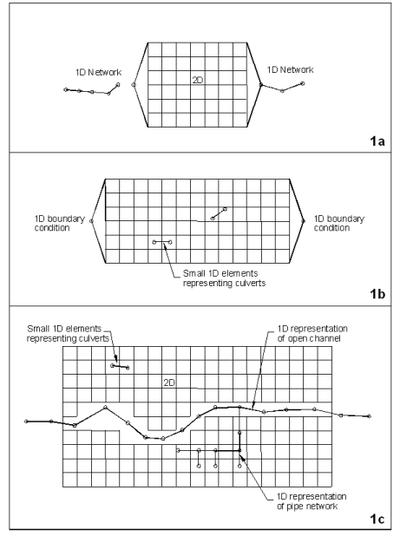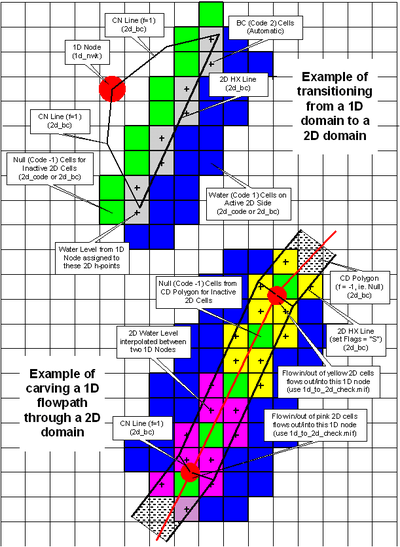SMS:TUFLOW Combining 1D and 2D Domains: Difference between revisions
No edit summary |
No edit summary |
||
| (14 intermediate revisions by the same user not shown) | |||
| Line 1: | Line 1: | ||
1D and 2D | 1D and 2D domains can be linked in three different ways. | ||
# A 2D domain within a 1D domain (1a) | # A 2D domain within a 1D domain (1a) | ||
# 1D elements representing culverts or pipe networks (1b or 1c) | # 1D elements representing culverts or pipe networks (1b or 1c) | ||
# 1D cross | # 1D cross section based domain for river channel and 2D domain for floodplain (1c) | ||
[[Image:TUFLOW 1D 2D linking mechanisms.png]] | :[[Image:TUFLOW 1D 2D linking mechanisms.png|thumb|none|left|400 px| Figure 1a: A 2D domain within a 1D domain. Figure 1b: 1D elements representing culverts or pipe networks. Figure 1c: 1D cross section based domain for river channel and 2D domain for floodplain. ]] | ||
===Linking 1D Pipe network within a 2D network=== | ===Linking 1D Pipe network within a 2D network=== | ||
The easiest way to link a 1D pipe network to a 2D network is to double click on one of the nodes in the network coverage and define an inlet (connection to the 2D domain). The inlet can be circular or rectangular and the shape and losses can be specified. | The easiest way to link a 1D pipe network to a 2D network is to double-click on one of the nodes in the network coverage and define an inlet (connection to the 2D domain). The inlet can be circular or rectangular and the shape and losses can be specified. | ||
===Linking 1D domain and 2D domains=== | ===Linking 1D domain and 2D domains=== | ||
Except for pipe networks defined above, linking a 1D network to a 2D network requires several coverages. | Except for pipe networks defined above, linking a 1D network to a 2D network requires several coverages. | ||
* Network coverage | * Network coverage – Contains the 1D channels | ||
* BC coverage | * BC coverage – 1D Flow/2D Water Level Connection (HX) or Flow source from a 1D model (SX) arcs define the interface between the 1D and 2D domains. | ||
* 1D/2D Connections | * 1D/2D Connections – Arcs connect 1D nodes to ends of 1D flow/2D water Level arcs or flow source arcs. When used with flow source arcs only 1 connection arc is needed where the 1D Flow/2D Water Level arcs require 2 arcs (one to each end of the arc). | ||
Arcs in the connections coverage must snap to the 1D network nodes and the endpoints of the 1D | Arcs in the connections coverage must snap to the 1D network nodes and the endpoints of the 1D flow/2D water level connection arcs. The snapping option setup in the ''Map'' tab of the [[SMS:Preferences|''Preferences'' dialog]] should be used to ensure that the nodes are placed correctly. | ||
The following image shows how 1D/2D linkages are setup both for | The following image shows how 1D/2D linkages are setup both for items 1 and 3 above. | ||
[[Image:TUFLOW transitioning1Dcross 2Ddomain.png]] | :[[Image:TUFLOW transitioning1Dcross 2Ddomain.png|thumb|none|left|400 px|1D/2D linkages setup]] | ||
{{Template: | ==Related Topics== | ||
*[[SMS:TUFLOW|TUFLOW]] | |||
{{Template:Navbox SMS}} | |||
[[Category:TUFLOW|Combining 1D/2D Domains]] | [[Category:TUFLOW|Combining 1D/2D Domains]] | ||
Latest revision as of 15:54, 9 October 2017
1D and 2D domains can be linked in three different ways.
- A 2D domain within a 1D domain (1a)
- 1D elements representing culverts or pipe networks (1b or 1c)
- 1D cross section based domain for river channel and 2D domain for floodplain (1c)
Linking 1D Pipe network within a 2D network
The easiest way to link a 1D pipe network to a 2D network is to double-click on one of the nodes in the network coverage and define an inlet (connection to the 2D domain). The inlet can be circular or rectangular and the shape and losses can be specified.
Linking 1D domain and 2D domains
Except for pipe networks defined above, linking a 1D network to a 2D network requires several coverages.
- Network coverage – Contains the 1D channels
- BC coverage – 1D Flow/2D Water Level Connection (HX) or Flow source from a 1D model (SX) arcs define the interface between the 1D and 2D domains.
- 1D/2D Connections – Arcs connect 1D nodes to ends of 1D flow/2D water Level arcs or flow source arcs. When used with flow source arcs only 1 connection arc is needed where the 1D Flow/2D Water Level arcs require 2 arcs (one to each end of the arc).
Arcs in the connections coverage must snap to the 1D network nodes and the endpoints of the 1D flow/2D water level connection arcs. The snapping option setup in the Map tab of the Preferences dialog should be used to ensure that the nodes are placed correctly.
The following image shows how 1D/2D linkages are setup both for items 1 and 3 above.
Related Topics
SMS – Surface-water Modeling System | ||
|---|---|---|
| Modules: | 1D Grid • Cartesian Grid • Curvilinear Grid • GIS • Map • Mesh • Particle • Quadtree • Raster • Scatter • UGrid |  |
| General Models: | 3D Structure • FVCOM • Generic • PTM | |
| Coastal Models: | ADCIRC • BOUSS-2D • CGWAVE • CMS-Flow • CMS-Wave • GenCade • STWAVE • WAM | |
| Riverine/Estuarine Models: | AdH • HEC-RAS • HYDRO AS-2D • RMA2 • RMA4 • SRH-2D • TUFLOW • TUFLOW FV | |
| Aquaveo • SMS Tutorials • SMS Workflows | ||

